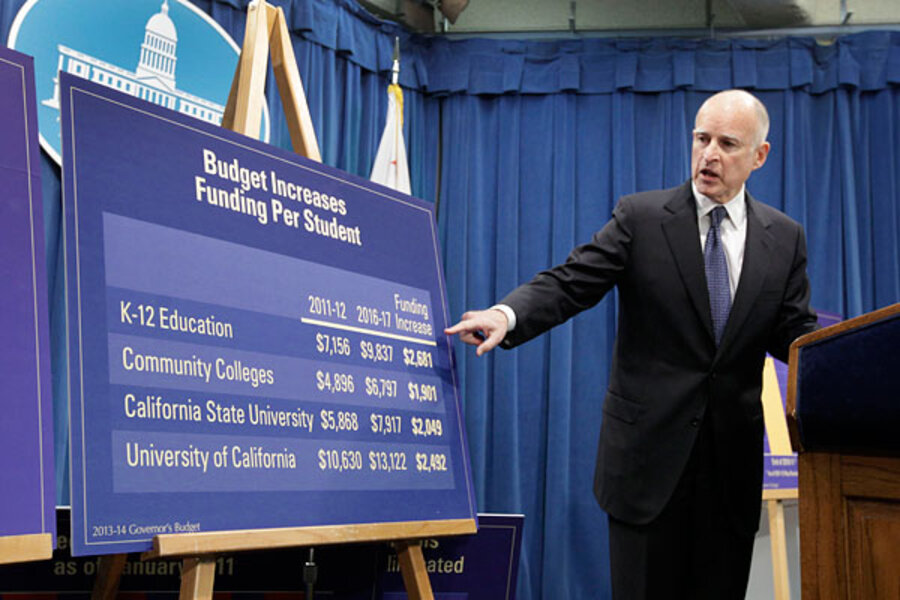Jerry Brown's second act: With California budget balanced, what now?
Loading...
| Los Angeles
When Gov. Jerry Brown (D) of California ascends to the podium for his third State of the State address Thursday morning, he will be faced with one overarching question: What will he do for a second act?
Since being elected in 2010, he has focused on fiscally turning around a state that ran deficits of as much as $27 billion annually. Last November, he got the last piece of his strategic puzzle when voters approved Proposition 30, Governor Brown's plea for a temporary tax hike.
Now, he says, the state is in the black (though some analysts dispute that). What no one disputes is that he has the wind in his sails, and that Wednesday's speech will go some way toward laying out where his administration is likely to go from here.
The problem is that California is still not in a position to loosen the purse strings, says Barbara O’Connor, director emeritus of the Institute for Study of Politics and Media at California State University, Sacramento.
“Jerry’s challenge is that he has to show that California can grow when it needs to grow in an era of fiscal austerity, and he has some real problems,” she says. “Yes, we are out of the woods, but we could turn back into the woods real quickly.”
The hurdles ahead include prison funding, education reform, climate change, and implementation of the federal health-care act.
Brown is also expected to take on two major infrastructure projects: a $23 billion set of underground canals to transport water from the Sacramento-San Joaquin Delta south and restore Delta habitat, and the first link of a $69 billion high-speed rail corridor.
How to maintain big ideas while spending wisely could hold lessons for other states.
“He is pushing forward a state that hasn't seen his brand of leadership in a generation or more,” says David McCuan, a political scientist at Sonoma State University. “Chris Christie of New Jersey may be the candid governor of the land, but Jerry Brown is the seasoned political pro who also thinks big and pushes ideas well before they seep into the public consciousness.”
Brown will need to use his powers of persuasion with the rail project, says Michael Shires, professor of public policy at Pepperdine University. It needs tens of billions of dollars that have yet to materialize from either voters or the federal government, and polls show that support from Californians is, at best, tepid.
In the Legislature, Brown has a Democratic supermajority. But that could be a problem, too, if Democrats use the more promising budget picture as an excuse to undo Brown's billions of dollars in cuts to education and social services, says Professor Shires.
“The greatest threat to his agenda will come not from business or the powerless Republican presence in Sacramento, but from within his own party as they clamor to entrench their more left-leaning agenda in the state’s fiscal and policy landscape before their two-thirds majority is put to the test in 2014,” he adds.
Moreover, the accuracy of Brown's Jan. 10 pronouncement that California is in the black is up for debate. It is premature to say that his $97 billion budget won't create new deficits, experts say.
“California's state budget is certainly in much better shape than in past years, but no one can predict that it is in the black until after the fiscal year is completed,” says Robert Stern, former president of the Center for Governmental Studies. “There are too many variables: federal funding, the up and down economy, and unforeseen events, such as wildfires, earthquakes, etc.”
Then there's the budget itself, which is an inexact document, says Professor McCuan.
“The budget numbers are a credit to this governor and his fiscal-nose-to-the-grindstone approach," he says. "But this has not come without some smoke and mirrors attached to the numbers – both for how we got here and how we got out.”
That is why experts are preaching caution.
“California has been painted as the poster child of profligate spending,” says Professor O’Connor. “The question is: Can it grow where it needs to grow and embrace the new century, while remaining sound fiscally? It is a real challenge. I think he can do it, and this speech will be the clues to how he will try.”





